 Buy Art Prints Now
Buy Art Prints Nowfrom Amazon
* As an Amazon Associate, and partner with Google Adsense and Ezoic, I earn from qualifying purchases.
Maincy Bridge, an oil on canvas work painted by Paul Cézanne is displayed in the Orsay Museum which is in Paris.
Although it might seem hard to believe for many years there was controversy about when and where Paul Cézanne painted Maincy Bridge. It has now been agreed that the painting dates from some time during the year of 1879. Subsequently, the real bridge has now been located on the river Almont close to the village of Maincy close to Melun. The bridge is still standing and appears much as seen in his painting. Cézanne was living at Melun which is close to the bridge during the time in which the painting was completed.
Water and trees are a recurring subject theme for Cézanne and are found in many of his paintings created during his career. As with many artists Cézanne's style and techniques developed during his career. Maincy bridge has become one of his first highly regarded masterpieces from what is termed as his mature style. Consequently, many future artists have found inspiration and used a similar style.
The long broad square and oblong brush strokes in this painting resemble a mosaic and seem simple and incomplete. Despite their simplicity, the use of strong colours combines to create a structure of stability and strength. Although his style shows influences from the pure impressionism and optical reality used by Monet Cézanne was moving away from the impressionist movement by concentrating on the structure and form of the subject alone. Natural objects and features being reduced to geometric shapes which helped to prevent them from distracting from the main subject of the picture.
Unlike Monet's work, there are no people or sentimental objects in this picture it is simple in that the subject is the bridge that stands out from the colourful and yet indistinct and formless background of vegetation and water in the foreground. The wooden footbridge has stone arches for support and fills the principal place in the picture apart from the two twisted tree trunks that stand in front of the bridge. Nothing detracts from the central subject. The colour of the stone arches being a lighter colour than most of the rest of the picture draw one's eyes directly to them. We then find something of a light colour in the water. It is not clear what the object is and I, as I am sure others will like me will be intrigued about what this object could be.




